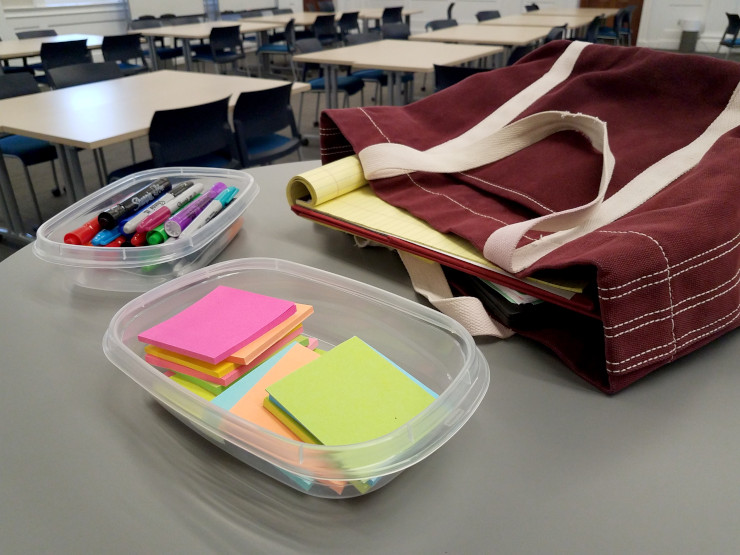I use to think that I needed to teach according to the models I’d seen as a student. I ran myself ragged trying recreate a half-formed ideas of what serious and rigorous classes “should” be and trying to act like I thought college teachers should act. I hated it. I hated it so much that I left teaching for ten years.
Now I don’t bother with any of that. I just want to design classes that I’d want to take. This is in part about choosing topics that I actually find interesting (as opposed to what might considered “important” from a disciplinary point of view), which turns out to match what students seem interested in. It’s also about the course design and teaching approach. If I were a student, what would I want to do during a class? What kinds of assignments would I find enriching (or at least not annoying)?
In general, I’d want to take a class that respected me as a learner (as opposed to condescending) and helped me reach my goals (as opposed to fulfilling requirements). I’d want it to be collaborative, hands-on, and relevant. And I’d want it to be fun.
When I came back to teaching and started to create my own classes, I had no idea how to do this kind of teaching. I could barely imagine it. Over the past few years, I’ve been learning and trying new things. Each semester is better than the previous. I’ve been getting good feedback from students, which is encouraging.
Here are some books that I’ve come across as I’ve been learning to design a class that I would like.
I haven’t found anyone who fully sums up what I’m trying to do, but these each contribute a few practical pieces. L. Dee Fink’s Creating Significant Learning Experiences vision of hands-on learning has been deeply inspiring and keeps opening up new possibilities for me.
Reading list
442173
ME7T8TG6
1
turabian-author-date
50
creator
asc
1
1
1
title
1822
https://www.restlessdevice.com/wp-content/plugins/zotpress/
%7B%22status%22%3A%22success%22%2C%22updateneeded%22%3Afalse%2C%22instance%22%3Afalse%2C%22meta%22%3A%7B%22request_last%22%3A0%2C%22request_next%22%3A0%2C%22used_cache%22%3Atrue%7D%2C%22data%22%3A%5B%7B%22key%22%3A%22M7N39VR2%22%2C%22library%22%3A%7B%22id%22%3A442173%7D%2C%22meta%22%3A%7B%22creatorSummary%22%3A%22Ambrose%20et%20al.%22%2C%22parsedDate%22%3A%222010-05-17%22%2C%22numChildren%22%3A1%7D%2C%22bib%22%3A%22%3Cdiv%20class%3D%5C%22csl-bib-body%5C%22%20style%3D%5C%22line-height%3A%201.35%3B%20padding-left%3A%201em%3B%20text-indent%3A-1em%3B%5C%22%3E%5Cn%20%3Cdiv%20class%3D%5C%22csl-entry%5C%22%3EAmbrose%2C%20Susan%20A.%2C%20Michael%20W.%20Bridges%2C%20Michele%20DiPietro%2C%20Marsha%20C.%20Lovett%2C%20Marie%20K.%20Norman%2C%20and%20Richard%20E.%20Mayer.%202010.%20%3Ci%3E%3Ca%20class%3D%27zp-ItemURL%27%20target%3D%27_blank%27%20href%3D%27http%3A%5C%2F%5C%2Fwww.worldcat.org%5C%2Foclc%5C%2F762968489%27%3EHow%20Learning%20Works%3A%20Seven%20Research-Based%20Principles%20for%20Smart%20Teaching%3C%5C%2Fa%3E%3C%5C%2Fi%3E.%201%20edition.%20San%20Francisco%2C%20CA%3A%20Jossey-Bass.%20%20%3Ca%20title%3D%27Cite%20in%20RIS%20Format%27%20class%3D%27zp-CiteRIS%27%20href%3D%27https%3A%5C%2F%5C%2Fwww.restlessdevice.com%5C%2Fwp-content%5C%2Fplugins%5C%2Fzotpress%5C%2Flib%5C%2Frequest%5C%2Frequest.cite.php%3Fapi_user_id%3D442173%26amp%3Bitem_key%3DM7N39VR2%27%3ECite%3C%5C%2Fa%3E%20%3C%5C%2Fdiv%3E%5Cn%3C%5C%2Fdiv%3E%22%2C%22data%22%3A%7B%22itemType%22%3A%22book%22%2C%22title%22%3A%22How%20Learning%20Works%3A%20Seven%20Research-Based%20Principles%20for%20Smart%20Teaching%22%2C%22creators%22%3A%5B%7B%22creatorType%22%3A%22author%22%2C%22firstName%22%3A%22Susan%20A.%22%2C%22lastName%22%3A%22Ambrose%22%7D%2C%7B%22creatorType%22%3A%22author%22%2C%22firstName%22%3A%22Michael%20W.%22%2C%22lastName%22%3A%22Bridges%22%7D%2C%7B%22creatorType%22%3A%22author%22%2C%22firstName%22%3A%22Michele%22%2C%22lastName%22%3A%22DiPietro%22%7D%2C%7B%22creatorType%22%3A%22author%22%2C%22firstName%22%3A%22Marsha%20C.%22%2C%22lastName%22%3A%22Lovett%22%7D%2C%7B%22creatorType%22%3A%22author%22%2C%22firstName%22%3A%22Marie%20K.%22%2C%22lastName%22%3A%22Norman%22%7D%2C%7B%22creatorType%22%3A%22author%22%2C%22firstName%22%3A%22Richard%20E.%22%2C%22lastName%22%3A%22Mayer%22%7D%5D%2C%22abstractNote%22%3A%22Praise%20for%20How%20Learning%20Works%20%5C%22How%20Learning%20Works%20is%20the%20perfect%20title%20for%20this%20excellent%20book.%20Drawing%20upon%20new%20research%20in%20psychology%2C%20education%2C%20and%20cognitive%20science%2C%20the%20authors%20have%20demystified%20a%20complex%20topic%20into%20clear%20explanations%20of%20seven%20powerful%20learning%20principles.%20Full%20of%20great%20ideas%20and%20practical%20suggestions%2C%20all%20based%20on%20solid%20research%20evidence%2C%20this%20book%20is%20essential%20reading%20for%20instructors%20at%20all%20levels%20who%20wish%20to%20improve%20their%20students%27%20learning.%5C%22%20%5Cu2014Barbara%20Gross%20Davis%2C%20assistant%20vice%20chancellor%20for%20educational%20development%2C%20University%20of%20California%2C%20Berkeley%2C%20and%20author%2C%20Tools%20for%20Teaching%20%5C%22This%20book%20is%20a%20must-read%20for%20every%20instructor%2C%20new%20or%20experienced.%20Although%20I%20have%20been%20teaching%20for%20almost%20thirty%20years%2C%20as%20I%20read%20this%20book%20I%20found%20myself%20resonating%20with%20many%20of%20its%20ideas%2C%20and%20I%20discovered%20new%20ways%20of%20thinking%20about%20teaching.%5C%22%20%5Cu2014Eugenia%20T.%20Paulus%2C%20professor%20of%20chemistry%2C%20North%20Hennepin%20Community%20College%2C%20and%202008%20U.S.%20Community%20Colleges%20Professor%20of%20the%20Year%20from%20The%20Carnegie%20Foundation%20for%20the%20Advancement%20of%20Teaching%20and%20the%20Council%20for%20Advancement%20and%20Support%20of%20Education%20%5C%22Thank%20you%20Carnegie%20Mellon%20for%20making%20accessible%20what%20has%20previously%20been%20inaccessible%20to%20those%20of%20us%20who%20are%20not%20learning%20scientists.%20Your%20focus%20on%20the%20essence%20of%20learning%20combined%20with%20concrete%20examples%20of%20the%20daily%20challenges%20of%20teaching%20and%20clear%20tactical%20strategies%20for%20faculty%20to%20consider%20is%20a%20welcome%20work.%20I%20will%20recommend%20this%20book%20to%20all%20my%20colleagues.%5C%22%20%5Cu2014Catherine%20M.%20Casserly%2C%20senior%20partner%2C%20The%20Carnegie%20Foundation%20for%20the%20Advancement%20of%20Teaching%20%5C%22As%20you%20read%20about%20each%20of%20the%20seven%20basic%20learning%20principles%20in%20this%20book%2C%20you%20will%20find%20advice%20that%20is%20grounded%20in%20learning%20theory%2C%20based%20on%20research%20evidence%2C%20relevant%20to%20college%20teaching%2C%20and%20easy%20to%20understand.%20The%20authors%20have%20extensive%20knowledge%20and%20experience%20in%20applying%20the%20science%20of%20learning%20to%20college%20teaching%2C%20and%20they%20graciously%20share%20it%20with%20you%20in%20this%20organized%20and%20readable%20book.%5C%22%20%5Cu2014From%20the%20Foreword%20by%20Richard%20E.%20Mayer%2C%20professor%20of%20psychology%2C%20University%20of%20California%2C%20Santa%20Barbara%3B%20coauthor%2C%20e-Learning%20and%20the%20Science%20of%20Instruction%3B%20and%20author%2C%20Multimedia%20Learning%22%2C%22date%22%3A%22May%2017%2C%202010%22%2C%22language%22%3A%22English%22%2C%22ISBN%22%3A%22978-0-470-48410-4%22%2C%22url%22%3A%22http%3A%5C%2F%5C%2Fwww.worldcat.org%5C%2Foclc%5C%2F762968489%22%2C%22collections%22%3A%5B%22Z3WC44V8%22%2C%22ME7T8TG6%22%5D%2C%22dateModified%22%3A%222022-02-04T18%3A49%3A42Z%22%7D%7D%2C%7B%22key%22%3A%22IMFJXE6B%22%2C%22library%22%3A%7B%22id%22%3A442173%7D%2C%22meta%22%3A%7B%22creatorSummary%22%3A%22Ball%20et%20al.%22%2C%22parsedDate%22%3A%222018%22%2C%22numChildren%22%3A0%7D%2C%22bib%22%3A%22%3Cdiv%20class%3D%5C%22csl-bib-body%5C%22%20style%3D%5C%22line-height%3A%201.35%3B%20padding-left%3A%201em%3B%20text-indent%3A-1em%3B%5C%22%3E%5Cn%20%3Cdiv%20class%3D%5C%22csl-entry%5C%22%3EBall%2C%20Cheryl%20E.%2C%20Jennifer%20Sheppard%2C%20and%20Kristin%20L.%20Arola.%202018.%20%3Ci%3E%3Ca%20class%3D%27zp-ItemURL%27%20target%3D%27_blank%27%20href%3D%27http%3A%5C%2F%5C%2Fwww.worldcat.org%5C%2Foclc%5C%2F1206416946%27%3EWriter%5C%2Fdesigner%3A%20a%20guide%20to%20making%20multimodal%20projects%3C%5C%2Fa%3E%3C%5C%2Fi%3E.%20Second%20edition.%20New%20York%2C%20Boston%3A%20Bedford%5C%2FStMartins.%20%20%3Ca%20title%3D%27Cite%20in%20RIS%20Format%27%20class%3D%27zp-CiteRIS%27%20href%3D%27https%3A%5C%2F%5C%2Fwww.restlessdevice.com%5C%2Fwp-content%5C%2Fplugins%5C%2Fzotpress%5C%2Flib%5C%2Frequest%5C%2Frequest.cite.php%3Fapi_user_id%3D442173%26amp%3Bitem_key%3DIMFJXE6B%27%3ECite%3C%5C%2Fa%3E%20%3C%5C%2Fdiv%3E%5Cn%3C%5C%2Fdiv%3E%22%2C%22data%22%3A%7B%22itemType%22%3A%22book%22%2C%22title%22%3A%22Writer%5C%2Fdesigner%3A%20a%20guide%20to%20making%20multimodal%20projects%22%2C%22creators%22%3A%5B%7B%22creatorType%22%3A%22author%22%2C%22firstName%22%3A%22Cheryl%20E.%22%2C%22lastName%22%3A%22Ball%22%7D%2C%7B%22creatorType%22%3A%22author%22%2C%22firstName%22%3A%22Jennifer%22%2C%22lastName%22%3A%22Sheppard%22%7D%2C%7B%22creatorType%22%3A%22author%22%2C%22firstName%22%3A%22Kristin%20L.%22%2C%22lastName%22%3A%22Arola%22%7D%5D%2C%22abstractNote%22%3A%22%22%2C%22date%22%3A%222018%22%2C%22language%22%3A%22eng%22%2C%22ISBN%22%3A%22978-1-319-05856-2%22%2C%22url%22%3A%22http%3A%5C%2F%5C%2Fwww.worldcat.org%5C%2Foclc%5C%2F1206416946%22%2C%22collections%22%3A%5B%22Z3WC44V8%22%2C%22ME7T8TG6%22%5D%2C%22dateModified%22%3A%222022-02-04T18%3A47%3A29Z%22%7D%7D%2C%7B%22key%22%3A%22M2KCP8CC%22%2C%22library%22%3A%7B%22id%22%3A442173%7D%2C%22meta%22%3A%7B%22creatorSummary%22%3A%22Barkley%22%2C%22parsedDate%22%3A%222010%22%2C%22numChildren%22%3A1%7D%2C%22bib%22%3A%22%3Cdiv%20class%3D%5C%22csl-bib-body%5C%22%20style%3D%5C%22line-height%3A%201.35%3B%20padding-left%3A%201em%3B%20text-indent%3A-1em%3B%5C%22%3E%5Cn%20%3Cdiv%20class%3D%5C%22csl-entry%5C%22%3EBarkley%2C%20Elizabeth%20F.%202010.%20%3Ci%3E%3Ca%20class%3D%27zp-ItemURL%27%20target%3D%27_blank%27%20href%3D%27http%3A%5C%2F%5C%2Fwww.worldcat.org%5C%2Foclc%5C%2F1288249521%27%3EStudent%20engagement%20techniques%3A%20a%20handbook%20for%20college%20faculty%3C%5C%2Fa%3E%3C%5C%2Fi%3E.%20Jossey-Bass%20Higher%20and%20Adult%20Education%20Series.%20San%20Francisco%3A%20Jossey-Bass.%20%20%3Ca%20title%3D%27Cite%20in%20RIS%20Format%27%20class%3D%27zp-CiteRIS%27%20href%3D%27https%3A%5C%2F%5C%2Fwww.restlessdevice.com%5C%2Fwp-content%5C%2Fplugins%5C%2Fzotpress%5C%2Flib%5C%2Frequest%5C%2Frequest.cite.php%3Fapi_user_id%3D442173%26amp%3Bitem_key%3DM2KCP8CC%27%3ECite%3C%5C%2Fa%3E%20%3C%5C%2Fdiv%3E%5Cn%3C%5C%2Fdiv%3E%22%2C%22data%22%3A%7B%22itemType%22%3A%22book%22%2C%22title%22%3A%22Student%20engagement%20techniques%3A%20a%20handbook%20for%20college%20faculty%22%2C%22creators%22%3A%5B%7B%22creatorType%22%3A%22author%22%2C%22firstName%22%3A%22Elizabeth%20F.%22%2C%22lastName%22%3A%22Barkley%22%7D%5D%2C%22abstractNote%22%3A%22From%20the%20Publisher%3A%20Keeping%20students%20involved%2C%20motivated%2C%20and%20actively%20learning%20is%20challenging%20educators%20across%20the%20country%2C%20yet%20good%20advice%20on%20how%20to%20accomplish%20this%20has%20not%20been%20readily%20available.%20Student%20Engagement%20Techniques%20is%20a%20comprehensive%20resource%20that%20offers%20college%20teachers%20a%20dynamic%20model%20for%20engaging%20students%20and%20includes%20over%20one%20hundred%20tips%2C%20strategies%2C%20and%20techniques%20that%20have%20been%20proven%20to%20help%20teachers%20from%20a%20wide%20variety%20of%20disciplines%20and%20institutions%20motivate%20and%20connect%20with%20their%20students.%20The%20ready-to-use%20format%20shows%20how%20to%20apply%20each%20of%20the%20book%27s%20techniques%20in%20the%20classroom%20and%20includes%20purpose%2C%20preparation%2C%20procedures%2C%20examples%2C%20online%20implementation%2C%20variations%20and%20extensions%2C%20observations%20and%20advice%2C%20and%20key%20resources.%22%2C%22date%22%3A%222010%22%2C%22language%22%3A%22eng%22%2C%22ISBN%22%3A%22978-0-470-28191-8%22%2C%22url%22%3A%22http%3A%5C%2F%5C%2Fwww.worldcat.org%5C%2Foclc%5C%2F1288249521%22%2C%22collections%22%3A%5B%22Z3WC44V8%22%2C%22ME7T8TG6%22%5D%2C%22dateModified%22%3A%222022-02-04T18%3A48%3A55Z%22%7D%7D%2C%7B%22key%22%3A%22IW9QBNZT%22%2C%22library%22%3A%7B%22id%22%3A442173%7D%2C%22meta%22%3A%7B%22creatorSummary%22%3A%22Brookfield%22%2C%22parsedDate%22%3A%222005%22%2C%22numChildren%22%3A1%7D%2C%22bib%22%3A%22%3Cdiv%20class%3D%5C%22csl-bib-body%5C%22%20style%3D%5C%22line-height%3A%201.35%3B%20padding-left%3A%201em%3B%20text-indent%3A-1em%3B%5C%22%3E%5Cn%20%3Cdiv%20class%3D%5C%22csl-entry%5C%22%3EBrookfield%2C%20Stephen.%202005.%20%3Ci%3E%3Ca%20class%3D%27zp-ItemURL%27%20target%3D%27_blank%27%20href%3D%27http%3A%5C%2F%5C%2Fwww.worldcat.org%5C%2Foclc%5C%2F862320275%27%3EDiscussion%20as%20a%20Way%20of%20Teaching%3A%20Tools%20and%20Techniques%20for%20Democratic%20Classrooms%3C%5C%2Fa%3E%3C%5C%2Fi%3E.%202nd%20ed.%20San%20Francisco%3A%20Jossey-Bass.%20%20%3Ca%20title%3D%27Cite%20in%20RIS%20Format%27%20class%3D%27zp-CiteRIS%27%20href%3D%27https%3A%5C%2F%5C%2Fwww.restlessdevice.com%5C%2Fwp-content%5C%2Fplugins%5C%2Fzotpress%5C%2Flib%5C%2Frequest%5C%2Frequest.cite.php%3Fapi_user_id%3D442173%26amp%3Bitem_key%3DIW9QBNZT%27%3ECite%3C%5C%2Fa%3E%20%3C%5C%2Fdiv%3E%5Cn%3C%5C%2Fdiv%3E%22%2C%22data%22%3A%7B%22itemType%22%3A%22book%22%2C%22title%22%3A%22Discussion%20as%20a%20Way%20of%20Teaching%3A%20Tools%20and%20Techniques%20for%20Democratic%20Classrooms%22%2C%22creators%22%3A%5B%7B%22creatorType%22%3A%22author%22%2C%22firstName%22%3A%22Stephen%22%2C%22lastName%22%3A%22Brookfield%22%7D%2C%7B%22creatorType%22%3A%22contributor%22%2C%22firstName%22%3A%22Stephen%22%2C%22lastName%22%3A%22Preskill%22%7D%5D%2C%22abstractNote%22%3A%22%22%2C%22date%22%3A%222005%22%2C%22language%22%3A%22%22%2C%22ISBN%22%3A%220-7879-7808-6%22%2C%22url%22%3A%22http%3A%5C%2F%5C%2Fwww.worldcat.org%5C%2Foclc%5C%2F862320275%22%2C%22collections%22%3A%5B%228SFFR3E6%22%2C%22Z3WC44V8%22%2C%22ME7T8TG6%22%5D%2C%22dateModified%22%3A%222022-02-04T18%3A50%3A16Z%22%7D%7D%2C%7B%22key%22%3A%228YQ5K74H%22%2C%22library%22%3A%7B%22id%22%3A442173%7D%2C%22meta%22%3A%7B%22creatorSummary%22%3A%22Brookfield%20and%20Preskill%22%2C%22parsedDate%22%3A%222016%22%2C%22numChildren%22%3A0%7D%2C%22bib%22%3A%22%3Cdiv%20class%3D%5C%22csl-bib-body%5C%22%20style%3D%5C%22line-height%3A%201.35%3B%20padding-left%3A%201em%3B%20text-indent%3A-1em%3B%5C%22%3E%5Cn%20%3Cdiv%20class%3D%5C%22csl-entry%5C%22%3EBrookfield%2C%20Stephen%2C%20and%20Stephen%20Preskill.%202016.%20%3Ci%3E%3Ca%20class%3D%27zp-ItemURL%27%20target%3D%27_blank%27%20href%3D%27http%3A%5C%2F%5C%2Fwww.worldcat.org%5C%2Foclc%5C%2F973620670%27%3EThe%20discussion%20book%3A%20fifty%20great%20ways%20to%20get%20people%20talking%3C%5C%2Fa%3E%3C%5C%2Fi%3E.%20San%20Francisco%2C%20CA%3A%20John%20Wiley%20%26%20Sons.%20%20%3Ca%20title%3D%27Cite%20in%20RIS%20Format%27%20class%3D%27zp-CiteRIS%27%20href%3D%27https%3A%5C%2F%5C%2Fwww.restlessdevice.com%5C%2Fwp-content%5C%2Fplugins%5C%2Fzotpress%5C%2Flib%5C%2Frequest%5C%2Frequest.cite.php%3Fapi_user_id%3D442173%26amp%3Bitem_key%3D8YQ5K74H%27%3ECite%3C%5C%2Fa%3E%20%3C%5C%2Fdiv%3E%5Cn%3C%5C%2Fdiv%3E%22%2C%22data%22%3A%7B%22itemType%22%3A%22book%22%2C%22title%22%3A%22The%20discussion%20book%3A%20fifty%20great%20ways%20to%20get%20people%20talking%22%2C%22creators%22%3A%5B%7B%22creatorType%22%3A%22author%22%2C%22firstName%22%3A%22Stephen%22%2C%22lastName%22%3A%22Brookfield%22%7D%2C%7B%22creatorType%22%3A%22author%22%2C%22firstName%22%3A%22Stephen%22%2C%22lastName%22%3A%22Preskill%22%7D%5D%2C%22abstractNote%22%3A%22%5C%22Do%20you%20need%20a%20resource%20that%20you%20can%20pull%20out%20of%20your%20pocket%20to%20liven%20up%20meetings%2C%20trainings%2C%20professional%20development%2C%20and%20teaching%3F%20The%20fifty%20easily%20applied%20techniques%20in%20this%20timely%20manual%20spur%20creativity%2C%20stimulate%20energy%2C%20keep%20groups%20focused%2C%20and%20increase%20participation.%20Whether%20you%27re%20teaching%20classes%2C%20facilitating%20employee%20training%2C%20leading%20organizational%20or%20community%20meetings%2C%20furthering%20staff%20and%20professional%20development%2C%20guiding%20town%20halls%2C%20or%20working%20with%20congregations%2C%20The%20Discussion%20Book%20is%20your%20go-to%20guide%20for%20improving%20any%20group%20process.%20Each%20of%20the%20concrete%20techniques%20and%20exercises%20is%20clearly%20described%20with%20guidance%20on%20selection%20and%20implementation%2C%20as%20well%20as%20advice%20on%20which%20pitfalls%20to%20avoid.%20All%20of%20the%20techniques%3A%20offer%20new%20ways%20to%20engage%20people%20and%20energize%20groups%3B%20get%20employees%2C%20students%2C%20colleagues%2C%20constituents%2C%20and%20community%20members%20to%20participate%20more%20fully%20in%20deliberative%20decision-making%3B%20encourage%20creativity%20and%20openness%20to%20new%20perspectives%3B%20increase%20collaboration%20and%20build%20cohesive%20teams%3B%20keep%20groups%20focused%20on%20important%20topics%20and%20hard-to-address%20issues.%20Derived%20from%20the%20authors%27%20decades%20of%20experience%20using%20these%20exercises%20with%20schools%2C%20colleges%2C%20corporations%2C%20the%20military%2C%20social%20movements%2C%20health%20care%20organizations%2C%20prisons%2C%20unions%2C%20non-profits%2C%20and%20elsewhere%2C%20The%20Discussion%20Book%20will%20help%20you%20guide%20discussions%20that%20matter%5C%22--Publisher%27s%20website%22%2C%22date%22%3A%222016%22%2C%22language%22%3A%22%22%2C%22ISBN%22%3A%22978-1-119-04971-5%22%2C%22url%22%3A%22http%3A%5C%2F%5C%2Fwww.worldcat.org%5C%2Foclc%5C%2F973620670%22%2C%22collections%22%3A%5B%22Z3WC44V8%22%2C%22ME7T8TG6%22%5D%2C%22dateModified%22%3A%222022-02-04T18%3A47%3A46Z%22%7D%7D%2C%7B%22key%22%3A%22CHCMSCVC%22%2C%22library%22%3A%7B%22id%22%3A442173%7D%2C%22meta%22%3A%7B%22creatorSummary%22%3A%22Fink%22%2C%22parsedDate%22%3A%222003%22%2C%22numChildren%22%3A2%7D%2C%22bib%22%3A%22%3Cdiv%20class%3D%5C%22csl-bib-body%5C%22%20style%3D%5C%22line-height%3A%201.35%3B%20padding-left%3A%201em%3B%20text-indent%3A-1em%3B%5C%22%3E%5Cn%20%3Cdiv%20class%3D%5C%22csl-entry%5C%22%3EFink%2C%20L.%20Dee.%202003.%20%3Ci%3E%3Ca%20class%3D%27zp-ItemURL%27%20target%3D%27_blank%27%20href%3D%27http%3A%5C%2F%5C%2Fwww.worldcat.org%5C%2Foclc%5C%2F700529130%27%3ECreating%20significant%20learning%20experiences%3A%20an%20integrated%20approach%20to%20designing%20college%20courses%3C%5C%2Fa%3E%3C%5C%2Fi%3E.%201st%20ed.%20Jossey-Bass%20Higher%20and%20Adult%20Education%20Series.%20San%20Francisco%2C%20Calif.%3A%20Jossey-Bass.%20%20%3Ca%20title%3D%27Cite%20in%20RIS%20Format%27%20class%3D%27zp-CiteRIS%27%20href%3D%27https%3A%5C%2F%5C%2Fwww.restlessdevice.com%5C%2Fwp-content%5C%2Fplugins%5C%2Fzotpress%5C%2Flib%5C%2Frequest%5C%2Frequest.cite.php%3Fapi_user_id%3D442173%26amp%3Bitem_key%3DCHCMSCVC%27%3ECite%3C%5C%2Fa%3E%20%3C%5C%2Fdiv%3E%5Cn%3C%5C%2Fdiv%3E%22%2C%22data%22%3A%7B%22itemType%22%3A%22book%22%2C%22title%22%3A%22Creating%20significant%20learning%20experiences%3A%20an%20integrated%20approach%20to%20designing%20college%20courses%22%2C%22creators%22%3A%5B%7B%22creatorType%22%3A%22author%22%2C%22firstName%22%3A%22L.%20Dee%22%2C%22lastName%22%3A%22Fink%22%7D%5D%2C%22abstractNote%22%3A%22Review%3A%20%5C%22Creating%20Significant%20Learning%20Experiences%20also%20offers%20valuable%20recommendations%20on%20what%20various%20organizations%20in%20higher%20education%20can%20do%20to%20more%20effectively%20support%20better%20teaching.%20Based%20on%20the%20six%20key%20needs%20of%20faculty%20interested%20in%20changing%20the%20way%20they%20teach%2C%20Fink%20identifies%20several%20specific%20actions%20for%20decision%20makers%20in%20colleges%20and%20universities%2C%20accrediting%20agencies%2C%20funding%20agencies%2C%20journals%20on%20teaching%2C%20and%20disciplinary%20associations.%5C%22%20%5C%22This%20book%20presents%20an%20exciting%20vision%20of%20what%20higher%20education%20might%20be%2C%20accompanied%20by%20practical%20advice%20on%20how%20to%20make%20that%20vision%20a%20reality.%5C%22--Jacket.%22%2C%22date%22%3A%222003%22%2C%22language%22%3A%22eng%22%2C%22ISBN%22%3A%22978-0-7879-6055-1%22%2C%22url%22%3A%22http%3A%5C%2F%5C%2Fwww.worldcat.org%5C%2Foclc%5C%2F700529130%22%2C%22collections%22%3A%5B%22Z3WC44V8%22%2C%22ME7T8TG6%22%5D%2C%22dateModified%22%3A%222022-02-04T18%3A49%3A15Z%22%7D%7D%2C%7B%22key%22%3A%22GT6R43YE%22%2C%22library%22%3A%7B%22id%22%3A442173%7D%2C%22meta%22%3A%7B%22creatorSummary%22%3A%22Hoidn%20and%20Klemen%5Cu010di%5Cu010d%22%2C%22parsedDate%22%3A%222020-07-29%22%2C%22numChildren%22%3A0%7D%2C%22bib%22%3A%22%3Cdiv%20class%3D%5C%22csl-bib-body%5C%22%20style%3D%5C%22line-height%3A%201.35%3B%20padding-left%3A%201em%3B%20text-indent%3A-1em%3B%5C%22%3E%5Cn%20%3Cdiv%20class%3D%5C%22csl-entry%5C%22%3EHoidn%2C%20Sabine%2C%20and%20Manja%20Klemen%5Cu010di%5Cu010d%2C%20eds.%202020.%20%3Ci%3E%3Ca%20class%3D%27zp-ItemURL%27%20target%3D%27_blank%27%20href%3D%27http%3A%5C%2F%5C%2Fwww.worldcat.org%5C%2Foclc%5C%2F1143838469%27%3EThe%20Routledge%20International%20Handbook%20of%20Student-Centered%20Learning%20and%20Teaching%20in%20Higher%20Education%3C%5C%2Fa%3E%3C%5C%2Fi%3E.%20London%3A%20Routledge.%20https%3A%5C%2F%5C%2Fdoi.org%5C%2F10.4324%5C%2F9780429259371.%20%3Ca%20title%3D%27Cite%20in%20RIS%20Format%27%20class%3D%27zp-CiteRIS%27%20href%3D%27https%3A%5C%2F%5C%2Fwww.restlessdevice.com%5C%2Fwp-content%5C%2Fplugins%5C%2Fzotpress%5C%2Flib%5C%2Frequest%5C%2Frequest.cite.php%3Fapi_user_id%3D442173%26amp%3Bitem_key%3DGT6R43YE%27%3ECite%3C%5C%2Fa%3E%20%3C%5C%2Fdiv%3E%5Cn%3C%5C%2Fdiv%3E%22%2C%22data%22%3A%7B%22itemType%22%3A%22book%22%2C%22title%22%3A%22The%20Routledge%20International%20Handbook%20of%20Student-Centered%20Learning%20and%20Teaching%20in%20Higher%20Education%22%2C%22creators%22%3A%5B%7B%22creatorType%22%3A%22editor%22%2C%22firstName%22%3A%22Sabine%22%2C%22lastName%22%3A%22Hoidn%22%7D%2C%7B%22creatorType%22%3A%22editor%22%2C%22firstName%22%3A%22Manja%22%2C%22lastName%22%3A%22Klemen%5Cu010di%5Cu010d%22%7D%5D%2C%22abstractNote%22%3A%22The%20movement%20away%20from%20teacher-centered%20toward%20student-centered%20learning%20and%20teaching%20%28SCLT%29%20in%20higher%20education%20has%20intensified%20in%20recent%20decades.%20Yet%20in%20spite%20of%20its%20widespread%20use%20in%20literature%20and%20policy%20documents%2C%20SCLT%20remains%20somewhat%20poorly%20defined%2C%20under-researched%20and%20often%20misinterpreted.%20Against%20this%20backdrop%2C%20The%20Routledge%20International%20Handbook%20of%20Student-Centered%20Learning%20and%20Teaching%20in%20Higher%20Education%20offers%20an%20original%2C%20comprehensive%20and%20up-to-date%20overview%20of%20the%20fundamentals%20of%20SCLT%20and%20its%20discussion%20and%20applications%20in%20policy%20and%20practice.%20%5Cn%5CnBringing%20together%2071%20scholars%20from%20around%20the%20world%2C%20the%20volume%20offers%20a%20most%20comprehensive%20and%20up-to-date%20overview%20of%20the%20fundamentals%20of%20SCLT%20and%20its%20applications%20in%20policy%20and%20practice%3B%20provides%20beacons%20of%20good%20practice%20that%20display%20how%20instructional%20expertise%20manifests%20itself%20in%20the%20quality%20of%20classroom%20learning%20and%20teaching%20and%20in%20the%20institutional%20environment%3B%20and%20critically%20discusses%20challenges%2C%20new%20directions%20and%20developments%20in%20pedagogy%2C%20course%20and%20study%20program%20design%2C%20classroom%20practice%2C%20assessment%20and%20institutional%20policy.%5Cn%5CnAn%20essential%20resource%2C%20this%20book%20uniquely%20offers%20researchers%2C%20educators%20and%20students%20in%20higher%20education%20new%20insights%20into%20the%20roots%2C%20latest%20thinking%2C%20practices%20and%20evidence%20surrounding%20SCLT%20in%20higher%20education.%22%2C%22date%22%3A%222020-07-29%22%2C%22language%22%3A%22%22%2C%22ISBN%22%3A%22978-0-429-25937-1%22%2C%22url%22%3A%22http%3A%5C%2F%5C%2Fwww.worldcat.org%5C%2Foclc%5C%2F1143838469%22%2C%22collections%22%3A%5B%22Z3WC44V8%22%2C%22ME7T8TG6%22%5D%2C%22dateModified%22%3A%222022-02-04T17%3A24%3A03Z%22%7D%7D%2C%7B%22key%22%3A%22GLXHZVZZ%22%2C%22library%22%3A%7B%22id%22%3A442173%7D%2C%22meta%22%3A%7B%22creatorSummary%22%3A%22hooks%22%2C%22parsedDate%22%3A%221994-09-12%22%2C%22numChildren%22%3A1%7D%2C%22bib%22%3A%22%3Cdiv%20class%3D%5C%22csl-bib-body%5C%22%20style%3D%5C%22line-height%3A%201.35%3B%20padding-left%3A%201em%3B%20text-indent%3A-1em%3B%5C%22%3E%5Cn%20%3Cdiv%20class%3D%5C%22csl-entry%5C%22%3Ehooks%2C%20bell.%201994.%20%3Ci%3E%3Ca%20class%3D%27zp-ItemURL%27%20target%3D%27_blank%27%20href%3D%27http%3A%5C%2F%5C%2Fwww.worldcat.org%5C%2Foclc%5C%2F1052744049%27%3ETeaching%20to%20Transgress%3A%20Education%20as%20the%20Practice%20of%20Freedom%3C%5C%2Fa%3E%3C%5C%2Fi%3E.%20New%20York%3A%20Routledge.%20%20%3Ca%20title%3D%27Cite%20in%20RIS%20Format%27%20class%3D%27zp-CiteRIS%27%20href%3D%27https%3A%5C%2F%5C%2Fwww.restlessdevice.com%5C%2Fwp-content%5C%2Fplugins%5C%2Fzotpress%5C%2Flib%5C%2Frequest%5C%2Frequest.cite.php%3Fapi_user_id%3D442173%26amp%3Bitem_key%3DGLXHZVZZ%27%3ECite%3C%5C%2Fa%3E%20%3C%5C%2Fdiv%3E%5Cn%3C%5C%2Fdiv%3E%22%2C%22data%22%3A%7B%22itemType%22%3A%22book%22%2C%22title%22%3A%22Teaching%20to%20Transgress%3A%20Education%20as%20the%20Practice%20of%20Freedom%22%2C%22creators%22%3A%5B%7B%22creatorType%22%3A%22author%22%2C%22firstName%22%3A%22bell%22%2C%22lastName%22%3A%22hooks%22%7D%5D%2C%22abstractNote%22%3A%22%22%2C%22date%22%3A%221994-09-12%22%2C%22language%22%3A%22English%22%2C%22ISBN%22%3A%22978-0-415-90808-5%22%2C%22url%22%3A%22http%3A%5C%2F%5C%2Fwww.worldcat.org%5C%2Foclc%5C%2F1052744049%22%2C%22collections%22%3A%5B%22Z3WC44V8%22%2C%22ME7T8TG6%22%5D%2C%22dateModified%22%3A%222022-02-04T17%3A24%3A49Z%22%7D%7D%2C%7B%22key%22%3A%22PU2DTUAE%22%2C%22library%22%3A%7B%22id%22%3A442173%7D%2C%22meta%22%3A%7B%22creatorSummary%22%3A%22hooks%22%2C%22parsedDate%22%3A%222003-08-25%22%2C%22numChildren%22%3A1%7D%2C%22bib%22%3A%22%3Cdiv%20class%3D%5C%22csl-bib-body%5C%22%20style%3D%5C%22line-height%3A%201.35%3B%20padding-left%3A%201em%3B%20text-indent%3A-1em%3B%5C%22%3E%5Cn%20%3Cdiv%20class%3D%5C%22csl-entry%5C%22%3Ehooks%2C%20bell.%202003.%20%3Ci%3E%3Ca%20class%3D%27zp-ItemURL%27%20target%3D%27_blank%27%20href%3D%27http%3A%5C%2F%5C%2Fwww.worldcat.org%5C%2Foclc%5C%2F1149477878%27%3ETeaching%20Community%3A%20A%20Pedagogy%20of%20Hope%3C%5C%2Fa%3E%3C%5C%2Fi%3E.%201st%20edition.%20New%20York%3A%20Routledge.%20%20%3Ca%20title%3D%27Cite%20in%20RIS%20Format%27%20class%3D%27zp-CiteRIS%27%20href%3D%27https%3A%5C%2F%5C%2Fwww.restlessdevice.com%5C%2Fwp-content%5C%2Fplugins%5C%2Fzotpress%5C%2Flib%5C%2Frequest%5C%2Frequest.cite.php%3Fapi_user_id%3D442173%26amp%3Bitem_key%3DPU2DTUAE%27%3ECite%3C%5C%2Fa%3E%20%3C%5C%2Fdiv%3E%5Cn%3C%5C%2Fdiv%3E%22%2C%22data%22%3A%7B%22itemType%22%3A%22book%22%2C%22title%22%3A%22Teaching%20Community%3A%20A%20Pedagogy%20of%20Hope%22%2C%22creators%22%3A%5B%7B%22creatorType%22%3A%22author%22%2C%22firstName%22%3A%22bell%22%2C%22lastName%22%3A%22hooks%22%7D%5D%2C%22abstractNote%22%3A%22%22%2C%22date%22%3A%222003-08-25%22%2C%22language%22%3A%22English%22%2C%22ISBN%22%3A%22978-0-415-96818-8%22%2C%22url%22%3A%22http%3A%5C%2F%5C%2Fwww.worldcat.org%5C%2Foclc%5C%2F1149477878%22%2C%22collections%22%3A%5B%22Z3WC44V8%22%2C%22ME7T8TG6%22%5D%2C%22dateModified%22%3A%222022-02-04T17%3A24%3A26Z%22%7D%7D%2C%7B%22key%22%3A%22VJC38DER%22%2C%22library%22%3A%7B%22id%22%3A442173%7D%2C%22meta%22%3A%7B%22creatorSummary%22%3A%22Incorporated%20and%20Weimer%22%2C%22numChildren%22%3A1%7D%2C%22bib%22%3A%22%3Cdiv%20class%3D%5C%22csl-bib-body%5C%22%20style%3D%5C%22line-height%3A%201.35%3B%20padding-left%3A%201em%3B%20text-indent%3A-1em%3B%5C%22%3E%5Cn%20%3Cdiv%20class%3D%5C%22csl-entry%5C%22%3EIncorporated%2C%20Magna%20Publications%2C%20and%20Maryellen%20Weimer.%20n.d.%20%3Ci%3E%3Ca%20class%3D%27zp-ItemURL%27%20target%3D%27_blank%27%20href%3D%27http%3A%5C%2F%5C%2Fwww.worldcat.org%5C%2Foclc%5C%2F993702028%27%3EActive%20Learning%3A%20A%20Practical%20Guide%20for%20College%20Faculty%3C%5C%2Fa%3E%3C%5C%2Fi%3E.%20%20%3Ca%20title%3D%27Cite%20in%20RIS%20Format%27%20class%3D%27zp-CiteRIS%27%20href%3D%27https%3A%5C%2F%5C%2Fwww.restlessdevice.com%5C%2Fwp-content%5C%2Fplugins%5C%2Fzotpress%5C%2Flib%5C%2Frequest%5C%2Frequest.cite.php%3Fapi_user_id%3D442173%26amp%3Bitem_key%3DVJC38DER%27%3ECite%3C%5C%2Fa%3E%20%3C%5C%2Fdiv%3E%5Cn%3C%5C%2Fdiv%3E%22%2C%22data%22%3A%7B%22itemType%22%3A%22book%22%2C%22title%22%3A%22Active%20Learning%3A%20A%20Practical%20Guide%20for%20College%20Faculty%22%2C%22creators%22%3A%5B%7B%22creatorType%22%3A%22author%22%2C%22firstName%22%3A%22Magna%20Publications%22%2C%22lastName%22%3A%22Incorporated%22%7D%2C%7B%22creatorType%22%3A%22author%22%2C%22firstName%22%3A%22Maryellen%22%2C%22lastName%22%3A%22Weimer%22%7D%5D%2C%22abstractNote%22%3A%22Interest%20in%20active%20learning%20on%20college%20campuses%20has%20grown%20dramatically%20in%20recent%20years.%20While%20no%20one%20sees%20traditional%20classroom%20practices%20ending%2C%20active%20learning%20has%20become%20a%20sought-after%20mode%20of%20instruction%20that%20is%20reshaping%20the%20way%20students%20learn%20and%20teachers%20teach.The%20push%20behind%20this%20change%20comes%20from%20active%20learning%27s%20potential%20to%20improve%20student%20success.%20Active%20learning%20can%20help%20students%20absorb%20and%20retain%20course%20material%20better%20than%20passive%20learning.%20Instead%20of%20simply%20memorizing%20what%20they%20read%20or%20reiterating%20what%20the%20teacher%20says%2C%20students%20think%20about%2C%20analyze%2C%20and%20synthesize%20the%20course%20material%20deeply.As%20with%20any%20promising%20but%20disruptive%20change%20to%20established%20norms%2C%20making%20active%20learning%20work%20efficiently%20can%20be%20problematic.%20Instructors%20have%20to%20know%20how%20to%20restructure%20their%20lectures%20to%20allow%20for%20more%20frequent%20interaction.%20Students%20need%20to%20be%20shown%20how%20to%20respond%20and%20participate%20in%20this%20new%20learning%20dynamic.%20Fortunately%2C%20it%27s%20easier%20than%20ever%20to%20learn%20from%20instructors%20at%20schools%20across%20the%20country%20who%20have%20integrated%20active%20learning%20into%20their%20classes.%20Their%20experiences%20and%20best%20practices%20for%20achieving%20success%20in%20active%20learning%20have%20been%20collected%20in%20a%20definitive%2C%20comprehensive%20resource%3A%20Active%20Learning%3A%20A%20Practical%20Guide%20for%20College%20Faculty.Whether%20you%20are%20new%20to%20active%20learning%20or%20have%20some%20familiarity%20and%20want%20to%20sharpen%20your%20proficiency%2C%20you%27ll%20find%20knowledgeable%2C%20reliable%20answers%20in%20these%20pages.%20This%20collection%20covers%20fundamental%20topics%20pertinent%20to%20active%20learning%2C%20discusses%20common%20problems%2C%20and%20provides%20solutions%20and%20options.%20Active%20Learning%3A%20A%20Practical%20Guide%20for%20College%20Faculty%20gives%20you%20incisive%20insights%2C%20including%20how%20to%3A%5Cu2022Facilitate%20learning%20with%20discussions%5Cu2022Manage%20heated%2C%20sensitive%2C%20or%20difficult%20classroom%20conversations%5Cu2022Incorporate%20active%20learning%20into%20the%20online%20classroom%5Cu2022Encourage%20experiential%20learning%5Cu2022Handle%20informal%20writing%20assignments%5Cu2022Use%20a%20quiz%20to%20jumpstart%20active%20learning%20in%20large%20classes%5Cu2022Assign%20students%20to%20the%20right%20groups%5Cu2022Choose%20and%20use%20group%20activities%20to%20foster%20learning%20%5Cu2022Integrate%20learning%20assessment%20techniques%20into%20your%20classes%5Cu2022Facilitate%20and%20assess%20small%20group%20activities%20Culled%20from%20the%20experiences%20of%20fellow%20educators%2C%20this%20book%20provides%20unique%20clarity.%20Developed%20by%20faculty%20for%20faculty%2C%20it%20can%20help%20you%20%5Cu2022Integrate%20active%20learning%20for%20the%20first%20time%20in%20your%20classroom%5Cu2022Hone%20your%20current%20active%20learning%20practices%5Cu2022Reach%20student-centered%20teaching%20goals%20with%20greater%20class%20involvement%5Cu2022Introduce%2C%20manage%2C%20and%20fulfill%20group%20work%20objectivesThis%20collection%20of%20authoritative%20articles%20is%20written%20in%20clear%2C%20accessible%20language%20for%20efficient%20comprehension.%20It%20includes%20an%20introduction%20by%20Maryellen%20Weimer%2C%20PhD%2C%20editor%20of%20The%20Teaching%20Professor%20newsletter%20and%20an%20award-winning%20professor%20emerita%20of%20teaching%20and%20learning%20at%20Penn%20State%20Berks.The%20insights%2C%20strategies%2C%20and%20techniques%20explored%20in%20Active%20Learning%3A%20A%20Practical%20Guide%20for%20College%20Faculty%20can%20help%20you%20excel%20with%20an%20active%20learning%20component%20in%20your%20classroom.%20It%20is%20an%20essential%20resource%20for%20every%20educator%20interested%20in%20how%20active%20learning%20can%20boost%20the%20accomplishments%20of%20their%20students.Magna%20Publications%20products%20are%20designed%20to%20help%20education%20professionals%20gain%20insights%20and%20build%20skills%20that%20improve%20the%20student%20learning%20experience.%20We%20strive%20to%20bring%20readers%20timely%2C%20indispensable%20content%20that%20can%20be%20put%20to%20immediate%20use.%20When%20you%20are%20ready%20to%20try%20a%20new%20pedagogical%20approach%20such%20as%20active%20learning%2C%20you%20can%20find%20what%20you%20need%20with%20Magna%20Publications.%22%2C%22date%22%3A%22%22%2C%22language%22%3A%22English%22%2C%22ISBN%22%3A%22%22%2C%22url%22%3A%22http%3A%5C%2F%5C%2Fwww.worldcat.org%5C%2Foclc%5C%2F993702028%22%2C%22collections%22%3A%5B%22Z3WC44V8%22%2C%22ME7T8TG6%22%5D%2C%22dateModified%22%3A%222022-02-04T18%3A50%3A01Z%22%7D%7D%2C%7B%22key%22%3A%222XRQHKMI%22%2C%22library%22%3A%7B%22id%22%3A442173%7D%2C%22meta%22%3A%7B%22creatorSummary%22%3A%22Kuhn%22%2C%22parsedDate%22%3A%222001%22%2C%22numChildren%22%3A1%7D%2C%22bib%22%3A%22%3Cdiv%20class%3D%5C%22csl-bib-body%5C%22%20style%3D%5C%22line-height%3A%201.35%3B%20padding-left%3A%201em%3B%20text-indent%3A-1em%3B%5C%22%3E%5Cn%20%20%3Cdiv%20class%3D%5C%22csl-entry%5C%22%3EKuhn%2C%20S.%202001.%20%26%23x201C%3BLearning%20from%20the%20Architecture%20Studio%3A%20Implications%20for%20Project-Based%20Pedagogy.%26%23x201D%3B%20%3Ci%3EInternational%20Journal%20Of%20Engineering%20Education%3C%5C%2Fi%3E%2017%2C%20no.%204%26%23x2013%3B5%3A%20349%26%23x2013%3B52.%20%3Ca%20title%3D%27Cite%20in%20RIS%20Format%27%20class%3D%27zp-CiteRIS%27%20href%3D%27https%3A%5C%2F%5C%2Fwww.restlessdevice.com%5C%2Fwp-content%5C%2Fplugins%5C%2Fzotpress%5C%2Flib%5C%2Frequest%5C%2Frequest.cite.php%3Fapi_user_id%3D442173%26amp%3Bitem_key%3D2XRQHKMI%27%3ECite%3C%5C%2Fa%3E%20%3C%5C%2Fdiv%3E%5Cn%3C%5C%2Fdiv%3E%22%2C%22data%22%3A%7B%22itemType%22%3A%22journalArticle%22%2C%22title%22%3A%22Learning%20from%20the%20architecture%20studio%3A%20Implications%20for%20project-based%20pedagogy%22%2C%22creators%22%3A%5B%7B%22creatorType%22%3A%22author%22%2C%22firstName%22%3A%22S.%22%2C%22lastName%22%3A%22Kuhn%22%7D%5D%2C%22abstractNote%22%3A%22%22%2C%22date%22%3A%222001%22%2C%22language%22%3A%22English%22%2C%22DOI%22%3A%22%22%2C%22ISSN%22%3A%220949-149X%22%2C%22url%22%3A%22%22%2C%22collections%22%3A%5B%22CNGC7ACT%22%2C%22ME7T8TG6%22%5D%2C%22dateModified%22%3A%222019-01-03T18%3A12%3A31Z%22%7D%7D%2C%7B%22key%22%3A%22XRFHT6TJ%22%2C%22library%22%3A%7B%22id%22%3A442173%7D%2C%22meta%22%3A%7B%22creatorSummary%22%3A%22Kuhn%22%2C%22parsedDate%22%3A%222021-07-12%22%2C%22numChildren%22%3A1%7D%2C%22bib%22%3A%22%3Cdiv%20class%3D%5C%22csl-bib-body%5C%22%20style%3D%5C%22line-height%3A%201.35%3B%20padding-left%3A%201em%3B%20text-indent%3A-1em%3B%5C%22%3E%5Cn%20%3Cdiv%20class%3D%5C%22csl-entry%5C%22%3EKuhn%2C%20Sarah.%202021.%20%3Ci%3E%3Ca%20class%3D%27zp-ItemURL%27%20target%3D%27_blank%27%20href%3D%27http%3A%5C%2F%5C%2Fwww.worldcat.org%5C%2Foclc%5C%2F1262015730%27%3ETransforming%20Learning%20Through%20Tangible%20Instruction%3A%20The%20Case%20for%20Thinking%20With%20Things%3C%5C%2Fa%3E%3C%5C%2Fi%3E.%201st%20edition.%20Routledge.%20%20%3Ca%20title%3D%27Cite%20in%20RIS%20Format%27%20class%3D%27zp-CiteRIS%27%20href%3D%27https%3A%5C%2F%5C%2Fwww.restlessdevice.com%5C%2Fwp-content%5C%2Fplugins%5C%2Fzotpress%5C%2Flib%5C%2Frequest%5C%2Frequest.cite.php%3Fapi_user_id%3D442173%26amp%3Bitem_key%3DXRFHT6TJ%27%3ECite%3C%5C%2Fa%3E%20%3C%5C%2Fdiv%3E%5Cn%3C%5C%2Fdiv%3E%22%2C%22data%22%3A%7B%22itemType%22%3A%22book%22%2C%22title%22%3A%22Transforming%20Learning%20Through%20Tangible%20Instruction%3A%20The%20Case%20for%20Thinking%20With%20Things%22%2C%22creators%22%3A%5B%7B%22creatorType%22%3A%22author%22%2C%22firstName%22%3A%22Sarah%22%2C%22lastName%22%3A%22Kuhn%22%7D%5D%2C%22abstractNote%22%3A%22%22%2C%22date%22%3A%222021-07-12%22%2C%22language%22%3A%22English%22%2C%22ISBN%22%3A%22%22%2C%22url%22%3A%22http%3A%5C%2F%5C%2Fwww.worldcat.org%5C%2Foclc%5C%2F1262015730%22%2C%22collections%22%3A%5B%22CNGC7ACT%22%2C%22ME7T8TG6%22%5D%2C%22dateModified%22%3A%222022-02-04T18%3A47%3A12Z%22%7D%7D%2C%7B%22key%22%3A%22ZNJMPATR%22%2C%22library%22%3A%7B%22id%22%3A442173%7D%2C%22meta%22%3A%7B%22creatorSummary%22%3A%22Kuhn%20and%20Davidson%22%2C%22parsedDate%22%3A%222007%22%2C%22numChildren%22%3A1%7D%2C%22bib%22%3A%22%3Cdiv%20class%3D%5C%22csl-bib-body%5C%22%20style%3D%5C%22line-height%3A%201.35%3B%20padding-left%3A%201em%3B%20text-indent%3A-1em%3B%5C%22%3E%5Cn%20%20%3Cdiv%20class%3D%5C%22csl-entry%5C%22%3EKuhn%2C%20Sarah%2C%20and%20Judith%20Davidson.%202007.%20%26%23x201C%3BThinking%20with%20Things%2C%20Teaching%20with%20Things%20-%20Enhancing%20Student%20Learning%20in%20Qualitative%20Research%20through%20Reflective%20Use%20of%20Tools%20and%20Materials.%26%23x201D%3B%20%3Ci%3EQualitative%20Research%20Journal%3C%5C%2Fi%3E%207%2C%20no.%202%3A%2063%26%23x2013%3B75.%20%3Ca%20class%3D%27zp-DOIURL%27%20target%3D%27_blank%27%20href%3D%27https%3A%5C%2F%5C%2Fdoi.org%5C%2F10.3316%5C%2FQRJ0702063%27%3Ehttps%3A%5C%2F%5C%2Fdoi.org%5C%2F10.3316%5C%2FQRJ0702063%3C%5C%2Fa%3E.%20%3Ca%20title%3D%27Cite%20in%20RIS%20Format%27%20class%3D%27zp-CiteRIS%27%20href%3D%27https%3A%5C%2F%5C%2Fwww.restlessdevice.com%5C%2Fwp-content%5C%2Fplugins%5C%2Fzotpress%5C%2Flib%5C%2Frequest%5C%2Frequest.cite.php%3Fapi_user_id%3D442173%26amp%3Bitem_key%3DZNJMPATR%27%3ECite%3C%5C%2Fa%3E%20%3C%5C%2Fdiv%3E%5Cn%3C%5C%2Fdiv%3E%22%2C%22data%22%3A%7B%22itemType%22%3A%22journalArticle%22%2C%22title%22%3A%22Thinking%20with%20things%2C%20teaching%20with%20things%20-%20Enhancing%20student%20learning%20in%20qualitative%20research%20through%20reflective%20use%20of%20tools%20and%20materials%22%2C%22creators%22%3A%5B%7B%22creatorType%22%3A%22author%22%2C%22firstName%22%3A%22Sarah%22%2C%22lastName%22%3A%22Kuhn%22%7D%2C%7B%22creatorType%22%3A%22author%22%2C%22firstName%22%3A%22Judith%22%2C%22lastName%22%3A%22Davidson%22%7D%5D%2C%22abstractNote%22%3A%22In%20this%20article%2C%20two%20experienced%20QR%20instructors%20argue%20that%20reflective%20attention%20to%20the%20tools%20and%20materials%20used%20by%20researchers%20and%20instructors%20can%20help%20to%20enhance%20student%20learning.%20Identifying%20three%20sorts%20of%20things%20in%20QR%20those%20on%20which%20research%20is%20conducted%20%28texts%2C%20images%2C%20etc.%29%3B%20the%20technologies%20used%20by%20the%20researcher%2C%20from%20software%20to%20notebooks%3B%20and%20the%20objects%20of%20the%20culture%20under%20study%20the%20authors%20discuss%20three%20examples%20of%20their%20use%20of%20things%20in%20the%20context%20of%20QR.%20A%20detailed%20case%20discussion%20based%20on%20the%20authors%27%20experience%20with%20flip%20chart%20paper%2C%20NVivo%20software%20and%20Tinkertoy%20concept%20maps%20reveals%20some%20of%20the%20benefits%20of%20attention%20to%20things.%20Based%20on%20their%20analysis%2C%20the%20authors%20conclude%20that%20there%20are%20four%20ways%20in%20which%20a%20focus%20on%20things%20can%20support%20learning%20and%20teaching%3A%20by%20scaffolding%20student%20understanding%2C%20by%20providing%20transparency%20in%20the%20learning%20and%20research%20process%2C%20by%20representing%20and%20supporting%20multiple%20views%20and%20perspectives%2C%20and%20by%20promoting%20reflexivity%20and%20reflection.%22%2C%22date%22%3A%222007%22%2C%22language%22%3A%22eng%22%2C%22DOI%22%3A%2210.3316%5C%2FQRJ0702063%22%2C%22ISSN%22%3A%221443-9883%22%2C%22url%22%3A%22%22%2C%22collections%22%3A%5B%22CNGC7ACT%22%2C%22ME7T8TG6%22%5D%2C%22dateModified%22%3A%222018-12-12T16%3A48%3A55Z%22%7D%7D%2C%7B%22key%22%3A%22T8FFDP4F%22%2C%22library%22%3A%7B%22id%22%3A442173%7D%2C%22meta%22%3A%7B%22creatorSummary%22%3A%22Lave%22%2C%22parsedDate%22%3A%221991%22%2C%22numChildren%22%3A1%7D%2C%22bib%22%3A%22%3Cdiv%20class%3D%5C%22csl-bib-body%5C%22%20style%3D%5C%22line-height%3A%201.35%3B%20padding-left%3A%201em%3B%20text-indent%3A-1em%3B%5C%22%3E%5Cn%20%3Cdiv%20class%3D%5C%22csl-entry%5C%22%3ELave%2C%20Jean.%201991.%20%3Ci%3E%3Ca%20class%3D%27zp-ItemURL%27%20target%3D%27_blank%27%20href%3D%27http%3A%5C%2F%5C%2Fwww.worldcat.org%5C%2Foclc%5C%2F1237590217%27%3ESituated%20learning%3A%20legitimate%20peripheral%20participation%3C%5C%2Fa%3E%3C%5C%2Fi%3E.%20Learning%20in%20Doing.%20Cambridge%20%5BEngland%5D%20%3B%20New%20York%3A%20Cambridge%20University%20Press.%20%20%3Ca%20title%3D%27Cite%20in%20RIS%20Format%27%20class%3D%27zp-CiteRIS%27%20href%3D%27https%3A%5C%2F%5C%2Fwww.restlessdevice.com%5C%2Fwp-content%5C%2Fplugins%5C%2Fzotpress%5C%2Flib%5C%2Frequest%5C%2Frequest.cite.php%3Fapi_user_id%3D442173%26amp%3Bitem_key%3DT8FFDP4F%27%3ECite%3C%5C%2Fa%3E%20%3C%5C%2Fdiv%3E%5Cn%3C%5C%2Fdiv%3E%22%2C%22data%22%3A%7B%22itemType%22%3A%22book%22%2C%22title%22%3A%22Situated%20learning%3A%20legitimate%20peripheral%20participation%22%2C%22creators%22%3A%5B%7B%22creatorType%22%3A%22author%22%2C%22firstName%22%3A%22Jean%22%2C%22lastName%22%3A%22Lave%22%7D%2C%7B%22creatorType%22%3A%22contributor%22%2C%22firstName%22%3A%22Etienne%22%2C%22lastName%22%3A%22Wenger%22%7D%5D%2C%22abstractNote%22%3A%22Publisher%27s%20description%3A%20In%20this%20important%20theoretical%20treatise%2C%20Jean%20Lave%2C%20anthropologist%2C%20and%20Etienne%20Wenger%2C%20computer%20scientist%2C%20push%20forward%20the%20notion%20of%20situated%20learning--that%20learning%20is%20fundamentally%20a%20social%20process%20and%20not%20solely%20in%20the%20learner%27s%20head.%20The%20authors%20maintain%20that%20learning%20viewed%20as%20situated%20activity%20has%20as%20its%20central%20defining%20characteristic%20a%20process%20they%20call%20legitimate%20peripheral%20participation.%20Learners%20participate%20in%20communities%20of%20practitioners%2C%20moving%20toward%20full%20participation%20in%20the%20sociocultural%20practices%20of%20a%20community.%20Legitimate%20peripheral%20participation%20provides%20a%20way%20to%20speak%20about%20crucial%20relations%20between%20newcomers%20and%20oldtimers%20and%20about%20their%20activities%2C%20identities%2C%20artifacts%2C%20knowledge%20and%20practice.%20The%20communities%20discussed%20in%20the%20book%20are%20midwives%2C%20tailors%2C%20quartermasters%2C%20butchers%2C%20and%20recovering%20alcoholics%2C%20however%2C%20the%20process%20by%20which%20participants%20in%20those%20communities%20learn%20can%20be%20generalized%20to%20other%20social%20groups.%22%2C%22date%22%3A%221991%22%2C%22language%22%3A%22eng%22%2C%22ISBN%22%3A%22978-0-521-41308-4%22%2C%22url%22%3A%22http%3A%5C%2F%5C%2Fwww.worldcat.org%5C%2Foclc%5C%2F1237590217%22%2C%22collections%22%3A%5B%22Z3WC44V8%22%2C%22ME7T8TG6%22%5D%2C%22dateModified%22%3A%222022-02-04T18%3A48%3A10Z%22%7D%7D%2C%7B%22key%22%3A%22GAB6I4IV%22%2C%22library%22%3A%7B%22id%22%3A442173%7D%2C%22meta%22%3A%7B%22creatorSummary%22%3A%22Weimer%22%2C%22parsedDate%22%3A%222013%22%2C%22numChildren%22%3A0%7D%2C%22bib%22%3A%22%3Cdiv%20class%3D%5C%22csl-bib-body%5C%22%20style%3D%5C%22line-height%3A%201.35%3B%20padding-left%3A%201em%3B%20text-indent%3A-1em%3B%5C%22%3E%5Cn%20%3Cdiv%20class%3D%5C%22csl-entry%5C%22%3EWeimer%2C%20Maryellen.%202013.%20%3Ci%3E%3Ca%20class%3D%27zp-ItemURL%27%20target%3D%27_blank%27%20href%3D%27http%3A%5C%2F%5C%2Fwww.worldcat.org%5C%2Foclc%5C%2F1096260248%27%3ELearner-Centered%20Teaching%3A%20Five%20Key%20Changes%20to%20Practice%3C%5C%2Fa%3E%3C%5C%2Fi%3E.%20Somerset%3A%20John%20Wiley%20%26%20Sons%2C%20Incorporated.%20%20%3Ca%20title%3D%27Cite%20in%20RIS%20Format%27%20class%3D%27zp-CiteRIS%27%20href%3D%27https%3A%5C%2F%5C%2Fwww.restlessdevice.com%5C%2Fwp-content%5C%2Fplugins%5C%2Fzotpress%5C%2Flib%5C%2Frequest%5C%2Frequest.cite.php%3Fapi_user_id%3D442173%26amp%3Bitem_key%3DGAB6I4IV%27%3ECite%3C%5C%2Fa%3E%20%3C%5C%2Fdiv%3E%5Cn%3C%5C%2Fdiv%3E%22%2C%22data%22%3A%7B%22itemType%22%3A%22book%22%2C%22title%22%3A%22Learner-Centered%20Teaching%3A%20Five%20Key%20Changes%20to%20Practice%22%2C%22creators%22%3A%5B%7B%22creatorType%22%3A%22author%22%2C%22firstName%22%3A%22Maryellen%22%2C%22lastName%22%3A%22Weimer%22%7D%5D%2C%22abstractNote%22%3A%22In%20this%20new%20edition%20of%20the%20classic%20work%2C%20one%20of%20the%20nation%27s%20most%20highly%20regarded%20authorities%20on%20effective%20college%20teaching%20offers%20a%20comprehensive%20introduction%20to%20the%20topic%20of%20learner-centered%20teaching%20in%20the%20college%20and%20university%20classroom%2C%20including%20the%20most%20up-to-date%20examples%20of%20practice%20in%20action%20from%20a%20variety%20of%20disciplines%2C%20an%20entirely%20new%20chapter%20on%20the%20research%20support%20for%20learner-centered%20approaches%2C%20and%20a%20more%20in-depth%20discussion%20of%20how%20students%27%20developmental%20issues%20impact%20the%20effectiveness%20of%20learner-centered%20teaching.%20Learner-Centered%20Teaching%20shows%20how%20to%20tie%20teaching%20and%20curriculum%20to%20the%20process%20and%20objectives%20of%20learning%20rather%20than%20to%20the%20content%20delivery%20alone..%2C%20Cover%20--%20Title%20page%20--%20Copyright%20page%20--%20Contents%20--%20Preface%20to%20the%20Second%20Edition%20--%20Acknowledgments%20--%20The%20Author%20--%20Part%20One%3A%20Foundations%20of%20the%20Learner-Centered%20Approach%20--%20Chapter%20One%3A%20Learner-Centered%20Teaching%3A%20Roots%20and%20Origins%20--%20A%20Personal%20History%20--%20Events%20and%20Experiences%3A%20What%20Motivated%20the%20Change%20--%20Organizing%20What%20I%20Learned%20--%20And%20the%20Learning%20Continues%20--%20The%20Theories%20Behind%20Learner-Centered%20Teaching%20--%20Attribution%20Theory%20and%20Self-Efficacy%20--%20Radical%20and%20Critical%20Pedagogy%20--%20Feminist%20Pedagogy%20--%20Constructivism%20--%20Transformative%20Learning%20--%20Chapter%20Two%3A%20Research%3A%20Evidence%20That%20Learner-Centered%20Approaches%20Work%20--%20Research%20Updates%20--%20Deep%20and%20Surface%20Learning%20--%20Faculty%20Orientations%20to%20Teaching%20--%20Independent%2C%20Self-Directed%2C%20and%20Self-Regulated%20Learners%20--%20Noteworthy%20Reviews%20of%20Research%20--%20Review%20of%20Research%20on%20Motivation%20--%20Reviews%20of%20Research%20on%20Active%20Learning%20--%20Discipline-Based%20Research%20in%20Support%20of%20Learner-Centered%20Approaches%20--%20Problem-Based%20Learning%20--%20Process-Oriented%20Guided%20Inquiry%20--%20Peer-Led%20Team%20Learning%20--%20Studies%20of%20Individual%20Learner-Centered%20Courses%20--%20Six%20Studies%20of%20Biology%20Courses%20--%20Study%20of%20an%20Algebra%20Course%20--%20Studies%20in%20Physics%20Courses%20--%20What%20Do%20Students%20Say%20About%20Learner-Centered%20Approaches%3F%20--%20Conclusion%20--%20Part%20Two%3A%20The%20Five%20Key%20Changes%20to%20Practice%20--%20Chapter%20Three%3A%20The%20Role%20of%20the%20Teacher%20--%20What%20Needs%20to%20Change%3F%20--%20What%20Hasn%5Cu2019t%20Changed%3F%20--%20Evidence%20of%20Teacher-Centered%20Instruction%20Provided%20by%20Faculty%20--%20Evidence%20of%20Teacher-Centered%20Instruction%20Provided%20by%20Students%20--%20Classroom%20Observation%20Data%20--%20Analysis%20of%20an%20Artifact%20of%20Teaching%20for%20Evidence%20of%20Active%20Learning%20--%20Why%20Hasn%5Cu2019t%20Teaching%20Become%20More%20Learner-Centered%3F%20--%20Why%20Faculty%20Prefer%20More%20Teacher-Centered%20Roles%20--%20The%20Facilitative%20Role%20Is%20More%20Difficult%20--%20Facilitative%20Teaching%3A%20Principles%20That%20Guide%20Its%20Implementation%20--%20Principle%201%3A%20Teachers%20Let%20Students%20Do%20More%20Learning%20Tasks%20--%20Principle%202%3A%20Teachers%20Do%20Less%20Telling%20So%20That%20Students%20Can%20Do%20More%20Discovering%20--%20Principle%203%3A%20Teachers%20Do%20Instructional%20Design%20Work%20More%20Carefully%20--%20Principle%204%3A%20Faculty%20More%20Explicitly%20Model%20How%20Experts%20Learn%20--%20Principle%205%3A%20Faculty%20Encourage%20Students%20to%20Learn%20From%20and%20With%20Each%20Other%20--%20Principle%206%3A%20Faculty%20and%20Students%20Work%20to%20Create%20Climates%20for%20Learning%20--%20Principle%207%3A%20Faculty%20Use%20Evaluation%20to%20Promote%20Learning%20--%20Interesting%20Implementation%20Issues%20--%20Do%20You%20Intervene%20and%2C%20If%20So%2C%20When%3F%20--%20How%20Best%20to%20Intervene%3F%20--%20Chapter%20Four%3A%20The%20Balance%20of%20Power%20--%20What%20Needs%20to%20Change%20and%20Hasn%5Cu2019t%3A%20Teacher%20Control%20--%20Changing%20the%20Balance%20of%20Power%20--%20Redistributing%20Power%3A%20Examples%20--%20Activities%20and%20Assignments%20--%20Course%20Policy%20Decisions%20--%20Course%20Content%20Decisions%20--%20Evaluation%20Activities%20--%20Interesting%20Implementation%20Issues%20--%20How%20Much%20Power%20Is%20Enough%20to%20Motivate%20Students%3F%20--%20How%20Much%20Decision%20Making%20Are%20Students%20Ready%20to%20Handle%3F%20--%20How%20Do%20Teachers%20Know%20When%20They%5Cu2019ve%20Abrogated%20Legitimate%20Instructional%20Responsibility%3F%20--%20Chapter%20Five%3A%20The%20Function%20of%20Content%20--%20What%20Needs%20to%20Change%3F%20--%20Why.%2C%20It%20Needs%20to%20Change%20--%20Why%20It%20Isn%5Cu2019t%20Changing%20--%20How%20Does%20Content%20Function%20in%20a%20Learner-Centered%20Course%3F%20--%20Developing%20Learning%20Skills%3A%20Guidelines%20--%20Strategies%20That%20Develop%20Learning%20Skills%20--%20Implementation%20Issues%20--%20How%20Do%20We%20Change%20Attitudes%20About%20the%20Function%20of%20Content%3F%20--%20Making%20the%20Strategies%20Work%20for%20Me%20--%20Chapter%20Six%3A%20The%20Responsibility%20for%20Learning%20--%20What%20Needs%20to%20Change%20and%20Still%20Hasn%5Cu2019t%20--%20Classroom%20Climates%20That%20Promote%20Student%20Responsibility%20for%20Learning%20--%20Classroom%20Climate%3A%20Definitions%20and%20Descriptions%20--%20Classroom%20Climates%20That%20Motivate%20Students%20to%20Accept%20the%20Responsibility%20for%20Learning%20--%20Student%20Involvement%20in%20Classroom%20Climate%20--%20Involving%20Students%20in%20Creating%20the%20Classroom%20Climate%20--%20Involving%20Students%20in%20Maintaining%20the%20Classroom%20Climate%20--%20Involving%20Students%20in%20Enhancing%20the%20Classroom%20Climate%20--%20Implementation%20Issues%20--%20Chapter%20Seven%3A%20The%20Purpose%20and%20Processes%20of%20Evaluation%20--%20What%20Needs%20to%20Change%20and%20Hasn%5Cu2019t%20--%20How%20the%20Purpose%20and%20Processes%20of%20Evaluation%20Change%20--%20A%20Better%20Balance%20Between%20Grades%20and%20Learning%20--%20Using%20Evaluation%20to%20Promote%20Self-%20and%20Peer-Assessment%20Skills%20--%20Using%20Exams%2C%20Assignments%2C%20and%20Activities%20to%20Promote%20Learning%20--%20Maximizing%20the%20Learning%20Potential%20of%20Exams%20--%20Developing%20Self-%20and%20Peer-Assessment%20Skills%20--%20Self-Assessment%3A%20Discovering%20What%20I%20Do%20and%20How%20Well%20I%20Do%20It%20--%20Peer%20Assessment%3A%20Discovering%20That%20I%20Can%20Give%20and%20Get%20Useful%20Feedback%20--%20Implementation%20Issues%20--%20Part%20Three%3A%20Implementing%20the%20Learner-Centered%20Approach%20--%20Chapter%20Eight%3A%20Responding%20to%20Resistance%20--%20Why%20Do%20Students%20Resist%3F%20--%20Learner-Centered%20Approaches%20Require%20More%20Work%20--%20Learner-Centered%20Approaches%20Are%20Threatening%20--%20Learner-Centered%20Approaches%20Involve%20Losses%20--%20Some%20Students%20Are%20Not%20Ready%20for%20Some%20Learner-Centered%20Approaches%20--%20Recognizing%20Resistance%20--%20Passive%2C%20Nonverbal%20Resistance%20--%20Partial%20Compliance%20--%20Open%20Resistance%20--%20Overcoming%20Resistance%20--%20Communicate%20Frequently%20and%20Explicitly%20About%20the%20Rationale%20for%20Learner-Centered%20Approaches%20--%20Communicate%20Messages%20That%20Encourage%20and%20Positively%20Reinforce%20--%20Solicit%20Student%20Feedback%20on%20Their%20Learning%20Experiences%20Regularly%20--%20Resist%20Their%20Resistance%20--%20Faculty%20Resistance%20--%20Sources%20of%20Faculty%20Resistance%20--%20Dealing%20with%20Faculty%20Resistance%20--%20Chapter%20Nine%3A%20Taking%20a%20Developmental%20Approach%20--%20The%20Developmental%20Process%3A%20What%20We%20Know%20--%20Developmental%20Design%20for%20Assignments%20and%20Activities%20--%20Progressive%20Design%20--%20Targeted%20Learning%20Skill%20Development%20--%20Developmental%20Curricular%20Design%20--%20Good%20Places%20to%20Begin%20--%20The%20Developmental%20Issues%20for%20Faculty%20--%20Appendix%20One%3A%20Syllabus%20and%20Learning%20Log%20Entries%20for%20Speech%20Communications%20100A%20--%20Text%20--%20Course%20Assignments%20--%20Exams%20--%20Presentations%20--%20Small-Group%20Experiences%20--%20Learning%20Log%20--%20Speech%20Critiques%20--%20Participation%20--%20Bonus%20Points%20--%20Grades%20--%20Learning%20Log%20Entries%20--%20Entry%201%20--%20Entry%202%20--%20Entry%203%20--%20Entry%204%20--%20Entry%205%20--%20Entry%206%20--%20Entry%207%20--%20Entry%208%20--%20Entry%209%20--%20Entry%2010%20--%20Entry%2011%20--%20Entry%2012%20--%20Entry%2013%20--%20Entry%2014%20--%20Entry%2015%20--%20Entry%2016%20--%20Entry%201.%2C%207%20--%20Entry%2018%20--%20Entry%2019%20--%20Entry%2020%20--%20Entry%2021%20--%20Entry%2022%20--%20Appendix%20Two%3A%20Resources%20That%20Develop%20Learning%20Skills%20--%20Successful%20Students%3A%20Guidelines%20and%20Thoughts%20for%20Academic%20Success%20--%20Ten%20Commandments%20for%20Effective%20Study%20Skills%20--%20Thou%20Shalt%20Be%20Responsible%20and%20Thou%20Shalt%20Be%20Active%5Cu2014For%20There%20Be%20No%20Other%20Passage%20to%20Academic%20Success%21%20--%20Thou%20Shalt%20Know%20Where%20Thy%20%5Cu201cHot%20Buttons%5Cu201d%20Are%2C%20and%20Thou%20Shalt%20Push%20Them%20Regularly%21%20--%20If%20Thou%20Hath%20Questions%2C%20Asketh%20Them%20--%20If%20Thou%20Hath%20No%20Questions%2C%20Maketh%20Some%21%20--%20Thou%20Shalt%20Learn%20That%20Thou%20and%20Thy%20Professor%20Maketh%20a%20Team%5Cu2014and%20Thou%20Shalt%20Be%20a%20Team%20Player%21%20--%20Thou%20Shalt%20Not%20Parketh%20Thy%20Butt%20in%20the%20Back%21%20--%20Thou%20Shalt%20Not%20Write%20in%20Thy%20Notes%20What%20Thou%20Faileth%20to%20Understand%21%20--%20If%20Thine%20Interest%20in%20Class%20Be%20Gone%2C%20Faketh%20It%21%20--%20Thou%20Shalt%20Know%20That%20if%20Silence%20Be%20Golden%2C%20Recitation%20Shalt%20Be%20Platinum%21%20--%20Thou%20Shalt%20Not%20Procrastinate%5Cu2014and%20Thou%20Shalt%20Beginneth%20Not%20Doing%20It%20Right%20Now%21%20--%20Discussion%20Guidelines%20for%20Students%20--%20Consider%20a%20Study%20Group%20--%20Group%20Members%5Cu2019%20Bill%20of%20Rights%20and%20Responsibilities%20--%20References%20--%20Name%20Index%20--%20Subject%20Index%20--%20.%22%2C%22date%22%3A%222013%22%2C%22language%22%3A%22eng%22%2C%22ISBN%22%3A%22978-1-118-11928-0%22%2C%22url%22%3A%22http%3A%5C%2F%5C%2Fwww.worldcat.org%5C%2Foclc%5C%2F1096260248%22%2C%22collections%22%3A%5B%22Z3WC44V8%22%2C%22ME7T8TG6%22%5D%2C%22dateModified%22%3A%222022-02-04T18%3A48%3A30Z%22%7D%7D%2C%7B%22key%22%3A%228JIWTX9N%22%2C%22library%22%3A%7B%22id%22%3A442173%7D%2C%22meta%22%3A%7B%22numChildren%22%3A0%7D%2C%22bib%22%3A%22%3Cdiv%20class%3D%5C%22csl-bib-body%5C%22%20style%3D%5C%22line-height%3A%201.35%3B%20padding-left%3A%201em%3B%20text-indent%3A-1em%3B%5C%22%3E%5Cn%20%3Cdiv%20class%3D%5C%22csl-entry%5C%22%3E%5C%22Making%20the%20Case%20for%20Active%2C%20Hands-On%20Learning%20in%20Higher%20Education%20%20%7C%20The%20College%20Puzzle.%5C%22%20n.d.%20Accessed%20December%2012%2C%202018.%20%20%3Ca%20title%3D%27Cite%20in%20RIS%20Format%27%20class%3D%27zp-CiteRIS%27%20href%3D%27https%3A%5C%2F%5C%2Fwww.restlessdevice.com%5C%2Fwp-content%5C%2Fplugins%5C%2Fzotpress%5C%2Flib%5C%2Frequest%5C%2Frequest.cite.php%3Fapi_user_id%3D442173%26amp%3Bitem_key%3D8JIWTX9N%27%3ECite%3C%5C%2Fa%3E%20%3C%5C%2Fdiv%3E%5Cn%3C%5C%2Fdiv%3E%22%2C%22data%22%3A%7B%22itemType%22%3A%22webpage%22%2C%22title%22%3A%22Making%20the%20Case%20for%20Active%2C%20Hands-On%20Learning%20in%20Higher%20Education%20%5Cu00a0%20%7C%20The%20College%20Puzzle%22%2C%22creators%22%3A%5B%5D%2C%22abstractNote%22%3A%22%22%2C%22date%22%3A%22%22%2C%22url%22%3A%22https%3A%5C%2F%5C%2Fcollegepuzzle.stanford.edu%5C%2Fmaking-the-case-for-active-hands-on-learning-in-higher-education%5C%2F%22%2C%22language%22%3A%22%22%2C%22collections%22%3A%5B%22CNGC7ACT%22%2C%22ME7T8TG6%22%5D%2C%22dateModified%22%3A%222018-12-12T17%3A07%3A34Z%22%7D%7D%5D%7D
Ambrose, Susan A., Michael W. Bridges, Michele DiPietro, Marsha C. Lovett, Marie K. Norman, and Richard E. Mayer. 2010.
How Learning Works: Seven Research-Based Principles for Smart Teaching . 1 edition. San Francisco, CA: Jossey-Bass.
Cite
Ball, Cheryl E., Jennifer Sheppard, and Kristin L. Arola. 2018.
Writer/designer: a guide to making multimodal projects . Second edition. New York, Boston: Bedford/StMartins.
Cite
Barkley, Elizabeth F. 2010.
Student engagement techniques: a handbook for college faculty . Jossey-Bass Higher and Adult Education Series. San Francisco: Jossey-Bass.
Cite
Brookfield, Stephen, and Stephen Preskill. 2016.
The discussion book: fifty great ways to get people talking . San Francisco, CA: John Wiley & Sons.
Cite
Fink, L. Dee. 2003.
Creating significant learning experiences: an integrated approach to designing college courses . 1st ed. Jossey-Bass Higher and Adult Education Series. San Francisco, Calif.: Jossey-Bass.
Cite
Hoidn, Sabine, and Manja Klemenčič, eds. 2020.
The Routledge International Handbook of Student-Centered Learning and Teaching in Higher Education . London: Routledge. https://doi.org/10.4324/9780429259371.
Cite
hooks, bell. 2003.
Teaching Community: A Pedagogy of Hope . 1st edition. New York: Routledge.
Cite
Incorporated, Magna Publications, and Maryellen Weimer. n.d.
Active Learning: A Practical Guide for College Faculty .
Cite
Kuhn, S. 2001. “Learning from the Architecture Studio: Implications for Project-Based Pedagogy.”
International Journal Of Engineering Education 17, no. 4–5: 349–52.
Cite
Kuhn, Sarah, and Judith Davidson. 2007. “Thinking with Things, Teaching with Things - Enhancing Student Learning in Qualitative Research through Reflective Use of Tools and Materials.”
Qualitative Research Journal 7, no. 2: 63–75.
https://doi.org/10.3316/QRJ0702063 .
Cite
Lave, Jean. 1991.
Situated learning: legitimate peripheral participation . Learning in Doing. Cambridge [England] ; New York: Cambridge University Press.
Cite
Weimer, Maryellen. 2013.
Learner-Centered Teaching: Five Key Changes to Practice . Somerset: John Wiley & Sons, Incorporated.
Cite
"Making the Case for Active, Hands-On Learning in Higher Education | The College Puzzle." n.d. Accessed December 12, 2018.
Cite
What kind of class would you want to take?
